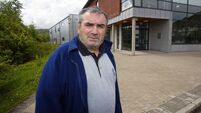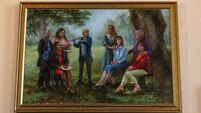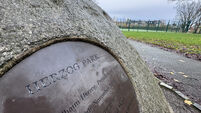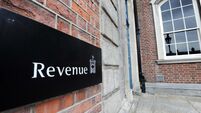Gerard Dooley: The impact Michael Collins had in just 31 years on Earth is impressive
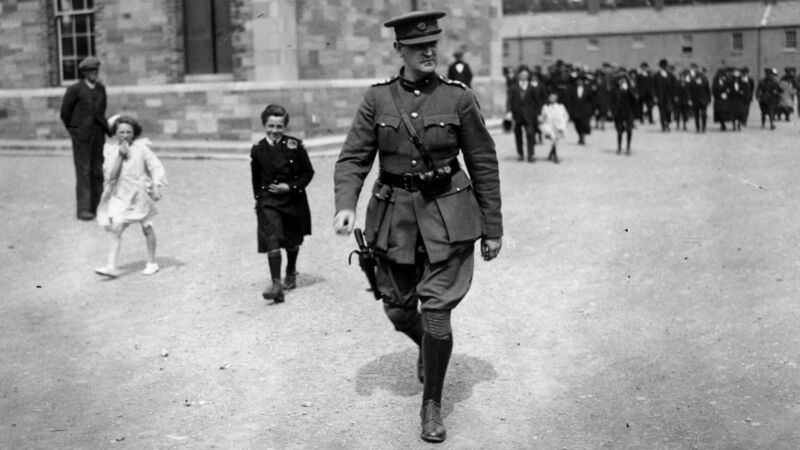
Michael Collins. Picture: Walshe/Getty Images
Picture the scene: A bus pulls up outside the Diamond Bar in the deserted crossroads of Béal na Bláth, West Cork. A score of men in varying stages of thirst barrel out.
The Diamond is the focal point of the crossroads. It stands alone, perpetually observing this confluence of roads. Above the door, we are reminded that the Diamond was once called Long’s Pub.
The 20 men had been on the road for hours. They had started their journey in a similar rural village — Camross, Co. Laois. They were made up of men from the Slieve Blooms, the hinterlands of Roscrea, Dublin, Galway, and Down. Had they done anything nefarious, songs may have been written about them.
As you have likely deduced, this was a stag party — my stag party.
It was October 29, 2016. Earlier that morning, somewhere along the banks of the River Bride, the best man had Googled hostelries in the area and had located a phone number for the Diamond. Despite not being long after 11am, hours before their usual opening time, the owner was happy to open his doors for refreshments.
HISTORY HUB
If you are interested in this article then no doubt you will enjoy exploring the various history collections and content in our history hub. Check it out HERE and happy reading
A century ago, this place was indeed known as Long’s Bar. Whilst retaining an essence of that time, some of the pictures on the wall had changed. There was a poster of Muhammad Ali sparring with his famous quip: “I’m so fast that last night I turned off the light switch in my bedroom and was in bed before the room was dark.”
There were images of local football teams. And, of course, there was a picture of “General Michael Collins, TD, Commander-in-Chief, National Army. Killed in Ambush, Co Cork, August 22, 1922.”
What this caption belies was the fact that not only was he killed in Cork, but it was only about a 10-minute walk from where the picture hung that Collins was killed and the pub itself was part of the story of that fateful day.
On that warm August Tuesday, Michael Collins’s convoy had departed Cork on a tour of west of the county. In Macroom, they had sought the help of Tim Kelleher, a local taxi driver, to navigate their way to Bandon. The main road was blocked with fallen trees and blown-up bridges.

When the convoy reached the crossroads in Béal na Bláth, they were flummoxed. The lead motorcyclist spotted a gentleman called Denny Long and asked him which was the best way to get to Bandon. Long duly shared directions and the convoy moved on.
As they passed by, Long spotted none other than Michael Collins sitting beside Emmet Dalton in an open-top car with an armoured car, the Slievenamon, bringing up the rear.
Long, whose name was above the door of the local pub, was acting as a watch out for a meeting of senior Cork Irish Republican Army (IRA) commanders. When he told them what he had saw, they decided to lay an ambush on the assumption that the convoy would return the way it had come.
Ninety-four years later, my stag party imbibed some late-morning porter in that same place. It was an innocent age pre-Covid and pre-cost-of-living-crisis — nothing on the handwritten price list breached the psychological threshold of a fiver.
The best man produced a full Irish volunteer outfit for the stag to wear for the remainder of the day. I feigned embarrassment as I nearly tore the sleeves enthusiastically pulling on the heavy jacket.
The proprietor of the Diamond, notwithstanding our patronage and generous support of the Newcestown GAA lottery, was probably rolling his eyes to heaven at such a spectacle.
For a lot of millennials, such as myself, our first memories of learning about Michael Collins were framed through the prism of Neil Jordan’s 1996 biopic. I remember being none too impressed when my parents would not bring me to see it. I was eight.
The story of the making of a feature film on Michael Collins is a saga in of itself. Jordan was putting pen to paper on a script for a Collins movie from the early 1980s, spurred on by David Puttnam who had been interested in such a project since the 1970s.
In 1984, Robert Redford was in talks to play Collins as part of a separate project. He had become interested in the Cork man in 1960 when researching for a role in James Costigan’s Broadway play, Little Moon of Alban.
By 1987, a $20m project written by Eoghan Harris and directed by Michael Cimino was being discussed in the media. Cimino had won an Oscar for The Deer Hunter but his career had plummeted following Heaven’s Gate, noted by some critics as the worst film ever made.
Gabriel Byrne and Mickey Rourke were among the names tipped to play the Cork man. However, Harris and Cimino had a “difference of opinion”, resulting in the former leaving the project.
Harris told The Irish Press at the time that Cimino “thinks he is making Scarface again”. One wonders how a Brian De Palma-esque portrayal of Collins may have panned out.
By the early 1990s, there were three parallel efforts to bring Michael Collins to the silver screen. Kevin Costner planned to direct and play the eponymous lead role. Greg Moscoe and Ira Trattner’s project, based on a script that John Huston had worked on before his death, was at an “advanced stage of development”.

But it was Jordan’s project which would eventually come to fruition. In early November 1994, an Evening Echo front-page story confirmed that ‘Neeson pips Costner for Collins role’.
The run-up to its release in Ireland was fraught with debate. It won the Golden Lion at the Venice Film Festival but was receiving lukewarm reviews in America. The Irish film censor, Sheamus Smith, took an “unprecedented” approach to the film.
Despite containing, in his own words “scenes depicting explicit cruelty and violence along with some crude language”, Smith argues that due to the “historical significance of this film” parents may wish to bring their children, so he devolved his responsibility to them.
It was a decision which raised many an eyebrow at the time. Jonathan Philbin Bowman, considering how an entirely new classification had effectively been created, wrote in the Sunday Independent: “So the certificate he kinda, sorta, thought that Michael Collins coulda, woulda, shoulda had was our old friend ‘U-12 acc. But in the face of Michael Collins’ correctness, he didn’t have the courage of his convictions.”
Michael Collins finally premiered in Ireland on November 6, 1996. Liam Neeson managed to attend both a reception before a charity screening in Cork and a red carpet screening in Dublin’s Savoy.
Jordan wrote in his diary when shooting the movie: “I realise that whatever the nature of the finished film, it will open a hornets’ nest”. He was right. While it was a commercial success, and did garner two Oscar nominations, his film was not universally praised.
Sile de Valera, Eamon’s grand-daughter, wrote “there is a great danger that children, who accept celluloid as fact, will miss the requirement that cinema has to cut corners and has to deliver a blockbuster”.
She also touches upon the fact that the dashing lead actor was known for his portrayal of good guys. Some of his most recent roles had been Oskar Schindler and Rob Roy McGregor.
Alan Rickman, on the other hand, was best known for playing Hans Gruber and the Sherriff of Nottingham — quintessential bad guys. When they were cast in the roles of Collins and de Valera, it was easy to see who was likely going to be portrayed in a more sympathetic light.
I was one of those children who accepted “celluloid as fact” — not helped by the fact that Collins would turn up a few years later as a Jedi whereas de Valera was Severus Snape.
It would largely take Leaving Cert History, an undergraduate degree in history, an MA in modern Irish history, and a secondary school history teaching qualification to shift this perspective to a more balanced view of the complexities of the time.
Despite learning all there is to know about his failures, I still admired Collins for his successes. Certain aspects of his legacy will be discussed enough by people far more qualified than myself this year.
So I will focus on one: What has always stood out to me was the impact that he had in such a short amount of time.
He was 31 when he died (de Valera had almost three times as long to forge a legacy). A veteran of the Easter Rising, he sat across a Downing Street table with some of the British Empire’s most wily and astute figures to play a part in negotiating a treaty that brought about an independent state for 26 of the 32 counties of Ireland.
He did all this despite being four years younger than the minimum age to be president of Ireland today. That age — 35 — was the average age of the Cabinet of the Provisional Government at the outbreak of the Civil War. By the outbreak of the Second World War, the average age of the Cabinet was almost 48. By 1957, this had risen to 65.
A century after the foundation of the State, people in their early 30s have far bigger headaches than not being able earn a seven-year stay in the Áras.
We struggle to live independently, in homes of our own. We live at home with our parents. We live hours from our place of work. We face choices that we were told would never have to be made again for Irish people.
We emigrated, returned, only to face potential for emigration once more. What has happened to the vibrant potential in the young hearts of those who fought and died for the Irish State?
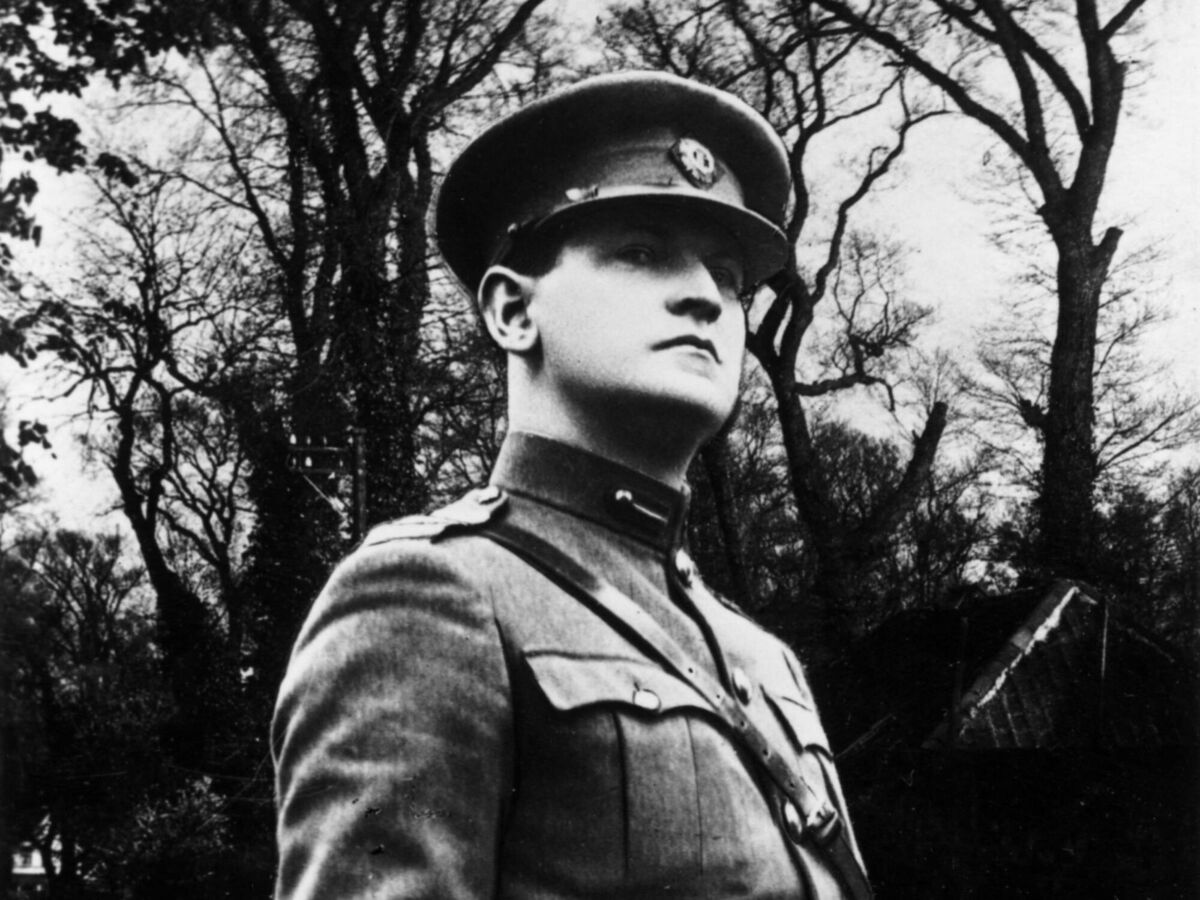
Back in the Diamond, with the hour approaching noon, the somewhat inebriated stag party vacated the premises and went to the nearby ambush site in the townland of Glannarouge West. There, in full uniform, I climbed the seven steps of the monument, and gave an impromptu account of Collins’s final days.
I was interrupted by an equally impromptu re-enactment of the ambush in which I unwittingly played the starring role — my brother taking on a role made famous by Jonathan Rhys Meyers.
I remember cars passing by at the time — no doubt with a similar expression to that of the proprietor of the Diamond a half hour earlier.
From there, we moved on to the Four Alls Bar at Sam’s Cross, where I gave another talk on Collins’s final days. This time less impromptu and with the aid of some AV. Cue more raised eyebrows from locals.
However, once they realised that I had a genuine appreciation for the man and the nuances of the Civil War, they acquiesced to the performance.
Collins had been in the Four Alls the day he was killed too. At that very bar we treated locals to a number of renditions of ‘Lovely Laois’, Collins bought Clonakilty Wrestlers for everyone in his convoy.
In fact, Collins had been in a number of public houses that day. It has long been said that his final journey was punctuated by drink, and that the events of Béal na Bláth may have been influenced by its effects.
Collins, himself, was not in great physical shape that week, suffering from a likely stomach ulcer that caused him issues for a year, so was unlikely to have partaken to the same extent as some of his colleagues.
From the time they set out from Cork’s Imperial Hotel, the convoy adopted a pretty laidback approach considering the fact that the head of the army was in a car without a roof and was traipsing around enemy territory.
The Slievenamon often was left at the rear struggling to keep up. At one point, when the armoured car disappeared altogether, the rest of the convoy turned around to locate it, only to find it pulled up in need of water outside a pub.
Its crew, perhaps in need of something a little bit stronger, were taking in the beautiful August weather. Collins said: “Sure the car needs a drink, why not the men?”
From the point at which they had lunch in Clonakilty, the tour took on the appearance of a leisurely jaunt among Collins’s people, with little real military need. Two of the final photographs of Collins show him in his open-top touring car leaving the Munster Arms in Bandon, and the Eldon Hotel in Skibbereen.
In Callinan’s of Roscarberry, a member of the convoy took advantage of a short visit by Collins to the elderly mother of a friend who had just died, to cause a ruckus.
Jock McPeake, the Scottish-born gunner of the Slievenamon, took a bottle of whiskey from the shelves which led to a scuffle between some of the Dubliners in the convoy and local troops.
By the time that they had left the Four Alls, they were apparently in “no shape for fighting”. According to an account given to Tim Pat Coogan, “they’d been on a bit of a spree all day”.
Despite statements to the contrary, including from Emmet Dalton who sat beside Collins as they drove into Béal na Bláth, there were likely people in the convoy who were under the effects of drink.
Undoubtedly, they were woefully unprepared to engage the IRA. However, according to Dalton, when he shouted to “drive like hell” when the shooting started at Béal na Bláth, it was Collins who told the driver to stop.
He may have been “the man who won the war”, but he was unused to the heat of such a battle. He left the cover of the Slievenamon to get a better view of the retreating IRA and was fatally wounded.
You have to think that if 13 years earlier when he was recruited into the London Irish Republican Brotherhood by Sam Maguire, he was told that his life would end one day in the sights of a gunman, Michael Collins could not have picked a better day for it than August 22, 1922.
A day spent among his family, his friends, his people, in the fading light of the setting sun in West Cork.
- Gerard Dooley, UCD College of Business and curator of @13Weeks project on Twitter

Subscribe to access all of the Irish Examiner.
Try unlimited access from only €1.50 a week
Already a subscriber? Sign in
CONNECT WITH US TODAY
Be the first to know the latest news and updates




